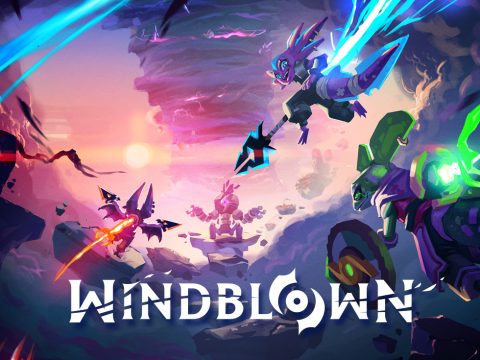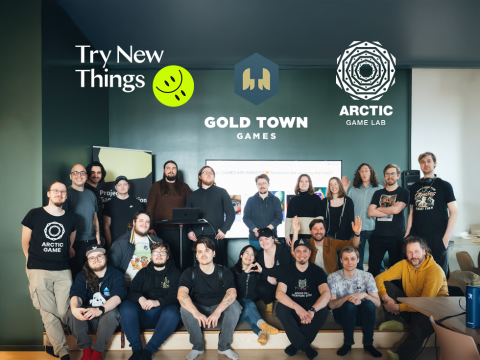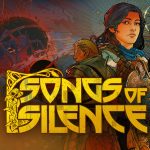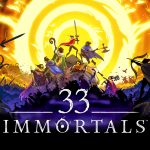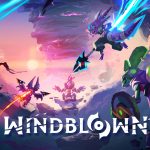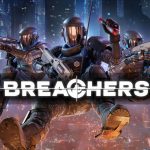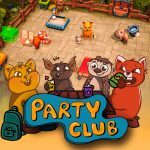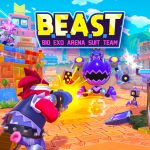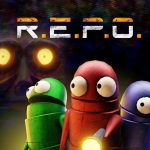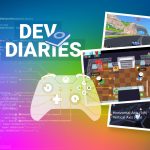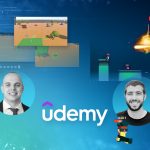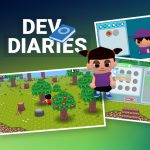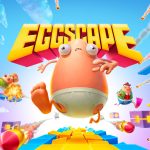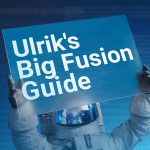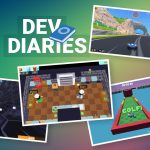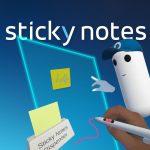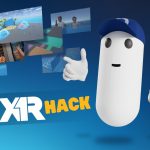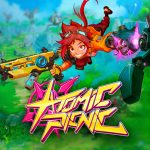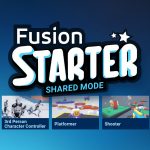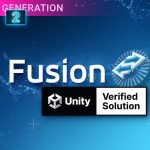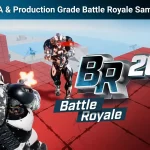The Road to Valor Hunters: How Two Devs Turned Chaos into Co-Op Fun
Every now and then, a co-op game comes along that reminds you why playing with friends is special, not because of high scores or fancy cinematics, but because of the laughter that erupts when everything goes completely off the rails. That’s exactly what HALE Gameworks set out to capture with Valor Hunters.
At first glance, it looks like a fast-paced bullet hell with endless enemy swarms. But underneath the mayhem lies a very intentional design philosophy: make cooperation messy, physical, and funny. Instead of clean, scripted interactions, Valor Hunters invites players to literally bump into each other, toss teammates across the battlefield, and pull off half-accidental rescues that somehow work. It’s co-op at its most human, imperfect, unpredictable, and endlessly replayable.
Behind this game is a two-person team that thrives on smart risks. With Unity and Photon Quantum as their backbone, HALE Gameworks built a foundation that could handle their brand of organized chaos without compromising on performance or ambition. It’s the kind of scrappy ingenuity that defines indie development at its best: working within limits, but never letting them define the game.

“For the challenges we faced, I’m confident Photon Quantum was not just the best choice – it was the only realistic choice. Setting up a working online game was hassle-free, and it embodies one of Hale Gameworks’ core philosophies: ‘It Just Works.’ Without Quantum, Valor Hunters simply wouldn’t exist with the features it has today.” – HALE Gameworks
Key Takeaways
- Embrace the chaos: Valor Hunters turns traditional co-op design on its head, making physical player interactions a core mechanic instead of a side effect.
- Small team, smart choices: With only two people, HALE Gameworks made the tough call to switch engines mid-project, a move that paid off big time.
- Tools that empower creativity: By building their own systems inspired by Unreal’s GAS, the team gave themselves the flexibility to create and test new ideas fast.
- Tech that scales with ambition: Photon Quantum’s deterministic networking lets the game handle huge battles and physics-driven madness without breaking a sweat.
- Community as a lifeline: The Photon Quantum Discord became an extension of the team, an instant source of answers, advice, and moral support.
- Ready for the world: Early playtests have been smooth, and the team is confident Valor Hunters will scale effortlessly when it launches in Early Access in 2026.

You are a small indie studio. How did the two of you come together, and what is your overall game development philosophy? Could you provide a brief overview of HALE Gameworks, its history, and its overarching vision in the game development industry?
Denis and I first met through a mutual friend, then ended up on the same team at Neon-Koi (part of PlayStation before it closed last year). We both felt that most co-op games are just scaled-up single-player experiences – we wanted features that would make games exponentially better when played with friends. So we founded HALE Gameworks earlier this year.
Our philosophy is simple: develop mid-scale games fast with a small team, create bloody good co-op experiences, and make games we’d actually want to play ourselves – games we’re proud to show off!
What was the driving motivation behind Valor Hunters? Can you elaborate on how you decided to make physical player interactions the central feature (like rope-binding, throwing, or piggybacking teammates)?
Funny thing – physical interactions weren’t even in our original plan! We started with a simple concept: bullet hell meets massive enemy hordes in co-op. But during development, we kept asking ourselves “how can we make co-op more interactive?” That’s when we started experimenting with players pushing each other, rope-binding, piggybacking – all that chaotic stuff.
We drew inspiration from games like It Takes Two and Human Fall Flat, where player interactions create these hilarious, unexpected moments. Actually, when we play, we still stumble upon moments where four heroes trying to rope bind and rotate around each other end up flying out of bounds – it’s chaos, but fun chaos!

What challenges did the unique gameplay mechanics of Valor Hunters, specifically the physical interactions and the need for 4-way Co-Op with massive hordes on screen, present to traditional networking solutions?
From past experience, we knew traditional server-authoritative models with replication would struggle with massive hordes – we’d be counting every byte and still barely making it work. Add physics-based player interactions? We’d need incredibly tight prediction/rollback systems on top of that authority model.
We’ve been down that road before and knew the pitfalls. After some (admittedly brief) deliberation, we were convinced: deterministic sim was the only way. That’s when we discovered Photon Quantum – exactly what we needed, already battle-tested. The only catch? The Unreal Engine plugin was still in early development.
You initially started development in Unreal Engine. Switching engines is a significant undertaking, especially for a small team. What was the exact reasoning that led you to switch entirely from Unreal Engine to Unity?
We got the Unreal early access plugin from the Photon team to test out, but they warned us it wasn’t production-ready. We’d already tried building our own deterministic solution for Unreal before – as a two-person team, we knew we couldn’t maintain and even have something viable, while also building the game.
Unity + Photon Quantum was the safest, most cost-effective choice for the long run. The migration took about a month, and sometimes you gotta be pragmatic!
You have built your own Skills System (similar to Unreal’s GAS), with a nice editor integration and a custom timeline tool. Can you elaborate on why you chose to do so and how beneficial it was to build such a custom tool for your game?
Both Denis and I come from tech backgrounds – we’re big believers in tool-driven development. With a small team, we needed designer-friendly tools to iterate fast and implement complex abilities easily.
We’d used Unreal’s GAS extensively over the years and loved it. So we recreated similar functionality – tag editors, gameplay effect data assets, ability assets – but completely reimagined under the hood for ECS and Photon Quantum. We even built a custom timeline tool for abilities that can run any logic through action data assets. None of this would’ve been possible without Quantum’s Data Assets pattern – that was a game-changer.

You successfully combined Unity + Photon Quantum’s ECS + some smart instancing on view code. How difficult was the learning curve for integrating Quantum’s ECS with Unity’s rendering stack and MonoBehaviours approach?
Quantum’s ECS was surprisingly straightforward – I’d worked with ECS + mass rendering before (Unreal’s Mass + Niagara), so the concepts clicked quickly. For Unity’s rendering and MonoBehaviours, we leveraged asset store packages for instanced animation rendering – took some trial and error, but we got there.
We’re extensively using object pooling for bullets, enemies, everything really. Currently supporting thousands of entities (bullets, interactables, enemies) without significant FPS drops. Rendering-wise, we can handle 10k+ meshes easily, though we don’t need that many. If we need to squeeze more performance, we’d optimize systems, add LODs, better scheduling – but we’re comfortable where we are.
How did Photon Quantum’s approach help a two-person team manage the synchronization and complexity inherent in these chaotic, deterministic physical interactions? Did you find that Quantum made the challenging task of multiplayer networking easier and how did you use Photon Quantum’s features to effectively handle massive hordes?
The beauty of deterministic netcode is you don’t worry about server synchronization – everyone runs the same simulation, so it’s like developing a single-player game in a way. Sure, you risk desyncs if code misbehaves, but Quantum’s tools and fixed-point math help us maintain determinism and catch issues quickly.
For the massive hordes, we developed custom lightweight movement systems – curve movements, kinematic formulas with LODs for variable tick rates. Very performant stuff that just works.
We also loved the samples provided – the Photon Quantum menu sample was super helpful, the Commands concept is elegant, and having out-of-the-box physics, player movement, and navigation support saved us tons of time.
If you had to summarize the experience for another indie studio hesitant about tackling complex multiplayer: In what specific way did the combination of Unity and Photon Quantum make Valor Hunters possible?
Unity’s beginner-friendly approach and easy tool creation is a huge win. Photon Quantum provides everything you need out-of-the-box for launching an online game. Moreover for us, supporting massive unit counts was the crucial feature, thus we proceeded with Photon Quantum.
Can you describe your experience with the support on Discord that the Photon Quantum team provided?
The community’s incredibly active – Erick and Ruhan from Photon, ipodtouch0218, a super-active member with big interest in Quantum, and others are always there with answers. We’re also in regular email contact with the team and catch up at game events for quick but valuable chats about best practices.
Our workflow is simple: check the docs (which are excellent), then hit Discord if we need clarification. Recently, when I was stuck on creating a lobby system and implementing game pausing, the Discord community provided best practice solutions that I could implement practically hassle-free. That kind of support is invaluable for a small team.
Valor Hunters is planned for EA release in Q2 2026. How confident are you that the foundation provided by Photon Quantum will scale seamlessly from your closed test to a full commercial launch?
Answer: Very confident. Other games have already launched successfully on Quantum – that track record is actually why we didn’t try building our own lockstep engine. We needed something proven, something that works. Our closed playtests have been smooth sailing, so we’re expecting the same for launch.

If there’s one thing Valor Hunters proves, it’s that you don’t need a massive team to build something bold, you just need the right mix of passion, persistence, and smart technology. HALE Gameworks has turned limitations into leverage, using Photon Quantum not just as a networking tool, but as a creative enabler.
Their journey is a great reminder that innovation often starts with asking the simplest question: “What if we did it differently?” For HALE Gameworks, that meant rethinking co-op from the ground up, making it feel less like synchronized dancing and more like an unpredictable bar fight between best friends.
As they move toward Early Access, Valor Hunters feels like more than just a debut title. It’s a statement of intent: that indie developers can, and should, chase big, ambitious multiplayer dreams. Because when the dust settles and the hordes are gone, what players remember isn’t just the victory, it’s the chaos they shared along the way.
Ready to build your own successful multiplayer game? With Fusion and Quantum by Photon, it’s never been easier to integrate cutting-edge multiplayer features into your project. We offer the industry’s most advanced tools, comprehensive support, and everything you need to get started – from downloadable samples to detailed documentation.
Take the first step today – download Fusion or download Quantum and start building. If you’re looking for in-depth assistance, join our Gaming Circle, where you can connect directly with our developers and get expert guidance throughout your journey.
Visit us on YouTube, BlueSky, X and LinkedIn or create a free Photon account and visit our Discord. We can’t wait to see what you create! For more developer insights and news make sure to check out our Photon Blog.
Your multiplayer success story starts here!

